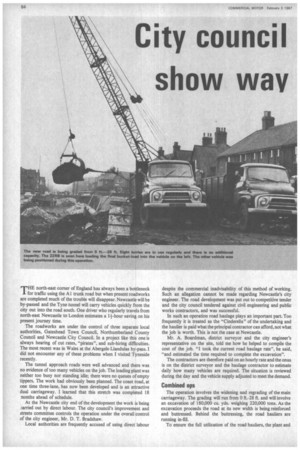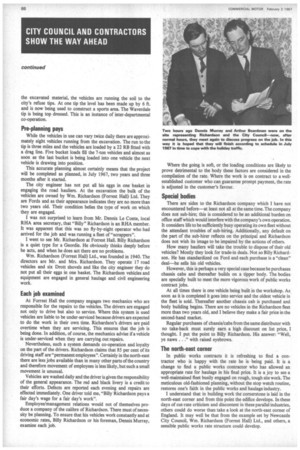City council and contractors show way
Page 86

Page 87

Page 88

If you've noticed an error in this article please click here to report it so we can fix it.
ahea(1 are constructed. Rates are designed for each specific job and the attendant circumstances of the iob are the author (left) how his rates taken into account.
PTHE north-east corner of England has always been a bottleneck
for traffic using the Al trunk road but when present roadworks are completed much of the trouble will disappear. Newcastle will be by-passed and the Tyne tunnel will carry vehicles quickly from the city out into the road south. One driver who regularly travels from north-east Newcastle to London estimates a 1÷-hour saving on his present journey time.
The roadworks are under the control of three separate local authorities, Gateshead Town Council, Northumberland County Council and Newcastle City Council. In a project like this one is always hearing of cut rates, "pirates", and sub-hiring difficulties. The most recent was in Wales at the Abergele-Llandulas by-pass. I did not encounter any of these problems when I visited Tyneside recently.
The tunnel approach roads were well advanced and there was no evidence of too many vehicles on the job. The loading plant was neither too busy nor standing idle; there were no queues of empty tippers. The work had obviously been planned. The coast road, at one time three-lane, has now been developed and is an attractive dual carriageway. I learned that this stretch was completed 18 -nonths ahead of schedule.
At the Newcastle city end of the development the work is being arried out by direct labour. The city council's improvement and streets committee controls the operation under the overall control of the city engineer, Mr. D. T. Bradshaw.
Local authorities are frequently accused of using direct labour despite the commercial inadvisability of this method of working. Such an allegation cannot be made regarding Newcastle's city engineer. The road development was put out to competitive tender and the city council tendered against civil engineering and public works contractors, and was successful.
In such an operation road haulage plays an important part. Too frequently it is treated as the "Cinderella" of the undertaking and the haulier is paid what the principal contractor can afford, not what the job is worth. This is not the case at Newcastle.
Mr. A. Boardman, district surveyor and the city engineer's representative on the site, told me how he helped to compile the cost of the job. "I took the current road haulage rate", he said, "and estimated the time required to complete the excavation".
The contractors are therefore paid on an hourly rate and the onus is on the district surveyor and the haulage contractor to estimate daily how many vehicles are required. The situation is reviewed during the day and the vehicle supply adjusted to meet the demand.
Combined ups
The operation involves the widening and regrading of the main carriageway. The grading will run from 0 ft.-28 ft. and will involve an excavation of 180,000 cu. yds. weighing 220,000 tons. As the excavation proceeds the road at its new width is being reinforced and buttressed. Behind the buttressing, the road hauliers are running in-fill.
To ensure the full utilization of the road hauliers, the plant and the excavated material, the vehicles are running the soil to the city's refuse tips. At one tip the level has been made up by 6 ft. and is now being used to construct a sports area. The Waverdale tip is being top dressed. This is an instance of inter-departmental co-operation.
Pre-planning pays While the vehicles in use can vary twice daily there are approximately eight vehicles running from the excavation. The run to the tip is three miles and the vehicles are loaded by a 22 RB fitted with a drag line. Five bucket loads fill the 7-ton vehicles and almost as soon as the last bucket is being loaded into one vehicle the next vehicle is drawing into position.
This accurate planning almost certainly means that the project will be completed as planned, in July 1967, two years and three months after it started.
The city engineer has not put all his eggs in one basket in engaging the road hauliers. At the excavation the bulk of the vehicles are owned by Wm. Richardson (Forrest Hall) Ltd. They are Fords and as their appearance indicates they are no more than two years old. Their condition belies the type of work on which they are engaged.
I was not surprised to learn from Mr. Dennis Le Conte, local RHA area secretary, that "Billy" Richardson is an RHA member. It was apparent that this was no fly-by-night operator who had arrived for the job and was running a fleet of "scrappers".
I went to see Mr. Richardson at Forrest Hall. Billy Richardson is a quiet type for a Geordie. He obviously thinks deeply before he acts, and when he does act there are no problems.
Wm. Richardson (Forrest Hall) Ltd., was founded in 1940. The directors are Mr. and Mrs. Richardson. They operate 17 road vehicles and six Drott shovels and like the city engineer they do not put all their eggs in one basket. The Richardson vehicles and equipment are engaged in general haulage and civil engineering work.
Each job examined At Forrest Hall the company engages two mechanics who are responsible for the repairs to the vehicles. The drivers are engaged not only to drive but also to service. Where this system is used vehicles are liable to be under-serviced because drivers are expected to do the work in their own time. Richardson's drivers are paid overtime when they are servicing. This ensures that the job is being done. In addition, of course, the mechanics advise if a vehicle is under-serviced when they are carrying out repairs.
Nevertheless, such a system demands co-operation and loyalty on the part of the drivers. Richardson claims that 85 per cent of its driving staff are "permanent employees". Certainly in the north-east there are less jobs available than in many other parts of the country and therefore movement of employees is less likely, but such a small movement is unusual.
Vehicles are washed daily and the driver is given the responsibility of the general appearance. The red and black livery is a credit to their efforts. Defects are reported each evening and repairs are effected immediately. One driver told me, "Billy Richardson pays a fair day's wage for a fair day's work".
Employee/management relations would not of themselves produce a company of the calibre of Richardson. There must of necessity be planning. To ensure that his vehicles work constantly and at economic rates, Billy Richardson or his foreman, Dennis Murray, examine each job. Where the going is soft, or the loading conditions are likely to prove detrimental to the body these factors are considered in the compilation of the rate. Where the work is on contract to a wellestablished customer who can guarantee prompt payment, the rate is adjusted in the customer's favour.
Special bodies There are sides to the Richardson company which I have not encountered before—at least not all at the same time. The company does not sub-hire; this is considered to be an additional burden on office staff which would interfere with the company's own operation. It considers life to be sufficiently busy operating its own fleet without the attendant troubles of sub-hiring. Additionally, any default on the part of the sub-hirer reflects on the principal and Richardson does not wish its image to be impaired by the actions of others.
How many hauliers will take the trouble to dispose of their old vehicles? Mostly they look for trade-in deals. Not so Billy Richardson. He has standardized on Ford and each purchase is a "clean" deal—he sells his old vehicles.
However, this is perhaps a very special case because he purchases chassis cabs and thereafter builds on a tipper body. The bodies are specially built to meet the more vigorous work of public works contract jobs.
At all times there is one vehicle being built in the workshop. As soon as it is completed it goes into service and the oldest vehicle in the fleet is sold. Thereafter another chassis cab is purchased and body building begins. There are no vehicles in the Richardson fleet more than two years old, and I believe they make a fair price in the second-hand market.
Regular purchases of chassis/cabs from the same distributor with no take-back must surely earn a high discount on list price, I thought. I put the point to Billy Richardson. His answer: "Well, ye naws . . ." with raised eyebrows.
The north-east corner In public works contracts it is refreshing to find a contractor who is happy with the rate he is being paid. It is a change to find a public works contractor who has allowed an appropriate rate for haulage in his final price. It is a joy to see a well-maintained fleet busily engaged on rough, tough site work. The meticulous old-fashioned planning, without the stop watch routine, restores one's faith in the public works and haulage industry.
I understand that in building work the cornerstone is laid in the north-east corner and from this point the edifice develops. In these days of cut-rate criticism and discontent in these parallel industries, others could do worse than take a look at the north-east corner of England. It may well be that from the example set by Newcastle City Council, Wm. Richardson (Forrest Hall) Ltd., and others, a sensible public works rate structure could develop.
















































































































































































